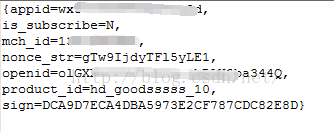最近,需要對(duì)客戶(hù)的接口做一個(gè)包裝,然后供自己公司別的系統(tǒng)調(diào)用,客戶(hù)接口是用HTTP URL實(shí)現(xiàn)的,我想用HttpClient包進(jìn)行請(qǐng)求,同時(shí)由于請(qǐng)求的URL是HTTPS的,為了避免需要證書(shū),所以用一個(gè)類(lèi)繼承DefaultHttpClient類(lèi),忽略校驗(yàn)過(guò)程。
1.寫(xiě)一個(gè)SSLClient類(lèi),繼承至HttpClient
|
1
2
3
4
5
6
7
8
9
10
11
12
13
14
15
16
17
18
19
20
21
22
23
24
25
26
27
28
29
30
31
32
33
34
35
36
37
38
|
package com.pcmall.service.sale.miaomore.impl; import java.security.cert.CertificateException; import java.security.cert.X509Certificate; import javax.net.ssl.SSLContext; import javax.net.ssl.TrustManager; import javax.net.ssl.X509TrustManager; import org.apache.http.conn.ClientConnectionManager; import org.apache.http.conn.scheme.Scheme; import org.apache.http.conn.scheme.SchemeRegistry; import org.apache.http.conn.ssl.SSLSocketFactory; import org.apache.http.impl.client.DefaultHttpClient; //用于進(jìn)行Https請(qǐng)求的HttpClient public class SSLClient extends DefaultHttpClient{ public SSLClient() throws Exception{ super(); SSLContext ctx = SSLContext.getInstance("TLS"); X509TrustManager tm = new X509TrustManager() { @Override public void checkClientTrusted(X509Certificate[] chain, String authType) throws CertificateException { } @Override public void checkServerTrusted(X509Certificate[] chain, String authType) throws CertificateException { } @Override public X509Certificate[] getAcceptedIssuers() { return null; } }; ctx.init(null, new TrustManager[]{tm}, null); SSLSocketFactory ssf = new SSLSocketFactory(ctx,SSLSocketFactory.ALLOW_ALL_HOSTNAME_VERIFIER); ClientConnectionManager ccm = this.getConnectionManager(); SchemeRegistry sr = ccm.getSchemeRegistry(); sr.register(new Scheme("https", 443, ssf)); } } |
2.寫(xiě)一個(gè)利用HttpClient發(fā)送post請(qǐng)求的類(lèi)
|
1
2
3
4
5
6
7
8
9
10
11
12
13
14
15
16
17
18
19
20
21
22
23
24
25
26
27
28
29
30
31
32
33
34
35
36
37
38
39
40
41
42
43
44
45
46
47
48
49
50
|
package com.pcmall.service.sale.miaomore.impl; import java.util.ArrayList; import java.util.Iterator; import java.util.List; import java.util.Map; import java.util.Map.Entry; import org.apache.http.HttpEntity; import org.apache.http.HttpResponse; import org.apache.http.NameValuePair; import org.apache.http.client.HttpClient; import org.apache.http.client.entity.UrlEncodedFormEntity; import org.apache.http.client.methods.HttpPost; import org.apache.http.message.BasicNameValuePair; import org.apache.http.util.EntityUtils; /* * 利用HttpClient進(jìn)行post請(qǐng)求的工具類(lèi) */public class HttpClientUtil { public String doPost(String url,Map<String,String> map,String charset){ HttpClient httpClient = null; HttpPost httpPost = null; String result = null; try{ httpClient = new SSLClient(); httpPost = new HttpPost(url); //設(shè)置參數(shù) List<NameValuePair> list = new ArrayList<NameValuePair>(); Iterator iterator = map.entrySet().iterator(); while(iterator.hasNext()){ Entry<String,String> elem = (Entry<String, String>) iterator.next(); list.add(new BasicNameValuePair(elem.getKey(),elem.getValue())); } if(list.size() > 0){ UrlEncodedFormEntity entity = new UrlEncodedFormEntity(list,charset); httpPost.setEntity(entity); } HttpResponse response = httpClient.execute(httpPost); if(response != null){ HttpEntity resEntity = response.getEntity(); if(resEntity != null){ result = EntityUtils.toString(resEntity,charset); } } }catch(Exception ex){ ex.printStackTrace(); } return result; } } |
3.調(diào)用post請(qǐng)求的測(cè)試代碼
|
1
2
3
4
5
6
7
8
9
10
11
12
13
14
15
16
17
18
19
20
21
22
23
24
25
26
27
28
29
|
package com.pcmall.service.sale.miaomore.impl; import java.util.HashMap; import java.util.Map; //對(duì)接口進(jìn)行測(cè)試 public class TestMain { private String url = "https://xxx.xxx.xxx/"; private String charset = "utf-8"; private HttpClientUtil httpClientUtil = null; public TestMain(){ httpClientUtil = new HttpClientUtil(); } public void test(){ String httpOrgCreateTest = url + "xxx/xxx/delivery"; Map<String,String> createMap = new HashMap<String,String>(); createMap.put("delivery_code","1D1QZ222Z22SM21A"); createMap.put("timestamp","1479198840000"); createMap.put("sign","F2109C333F3EADE929F932E89703FA0F683D43EB"); String httpOrgCreateTestRtn = httpClientUtil.doPost(httpOrgCreateTest,createMap,charset); System.out.println("result:"+httpOrgCreateTestRtn); } public static void main(String[] args){ TestMain main = new TestMain(); main.test(); } } |
剛開(kāi)始不是很明白BasicNameValuePair的用法,后來(lái)慢慢摸索了一下,發(fā)現(xiàn)BasicNameValuePair是存儲(chǔ)鍵值對(duì)的類(lèi),當(dāng)添加新的key和value值,它會(huì)自動(dòng)給裝換成http的格式,=和&符號(hào),比如https://xxx.xxx.xxx/xxx/xxxx/delivery?delivery_code=DQZZSM2A×tamp=1479198840000&sign=F209C33FEADE99F93E8970FA0F68D3EB,我們都不用自己進(jìn)行拼接和匹配了,個(gè)人覺(jué)得它用起來(lái)還是挺方便而且準(zhǔn)確度也高,希望可以幫助到大家!
以上就是小編為大家?guī)?lái)的JAVA利用HttpClient進(jìn)行POST請(qǐng)求(HTTPS)實(shí)例全部?jī)?nèi)容了,希望大家多多支持服務(wù)器之家~















